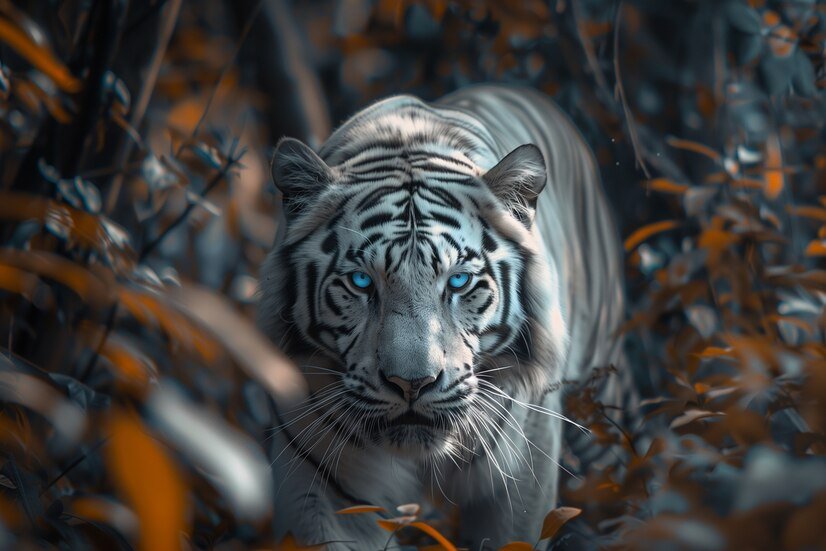Introduction to Black Tigers
Black tigers are among the rarest and most captivating animals in the world. With their striking coat and elusive nature, these magnificent creatures have intrigued wildlife enthusiasts and photographers alike. Capturing a black tiger on camera is not just about snapping a picture; it’s an opportunity to showcase one of nature’s wonders. But photographing these stunning big cats comes with its own set of challenges.
From understanding their behavior to mastering the right techniques, every step plays a crucial role in achieving that perfect shot. Whether you’re an amateur photographer or seasoned professional, learning how to photograph black tigers effectively can elevate your skills and deepen your appreciation for this incredible species. Let’s dive into what it takes to capture the essence of these majestic animals through your lens!
Understanding the Challenges of Photographing Black Tigers
Photographing black tigers presents unique challenges that can test any photographer’s skills. Their distinct dark coats blend seamlessly into the shadows of their natural habitats, making them difficult to spot and capture.
Lighting conditions play a critical role in this endeavor. The dense forests where these magnificent creatures roam often result in low light situations, which can hinder image clarity. A flash is typically ineffective due to the overwhelming darkness surrounding them.
Moreover, patience is key. Black tigers are elusive by nature, often choosing to remain hidden for long periods. This means photographers must wait silently for hours or even days for a fleeting moment when they might reveal themselves.
Capturing their expressive eyes is crucial yet challenging. Those deep-set eyes are windows to their souls but require perfect timing and angle to truly shine through in photographs. Each shot demands attention and skill—an art form unto itself.
Equipment and Settings for Photographing Black Tigers
When it comes to photographing black tigers, the right equipment can make all the difference. Start with a DSLR or mirrorless camera that offers excellent low-light performance. Look for lenses with a wide aperture, ideally 2.8 or lower, to capture sharp images in dim settings.
A telephoto lens will allow you to maintain distance while still getting close-up shots of these magnificent creatures. Something in the range of 200mm to 600mm is ideal for wildlife photography.
Settings are crucial too. Use a higher ISO setting when light diminishes—this helps preserve details without introducing too much noise. Shutter speed should be fast enough (1/500s or faster) to freeze their movement, especially if they’re on the prowl.
Don’t forget about stabilization! A tripod or monopod can help keep your shots steady and focused despite variable lighting conditions in their habitat.
Tips for Capturing the Best Shots
Capturing breathtaking shots of a black tiger requires patience and skill. Start by observing their behavior. Understanding when they are most active can greatly enhance your chances of getting that perfect shot.
Use burst mode on your camera to capture multiple frames in quick succession. This technique is invaluable for freezing moments, especially during play or hunting sequences.
Consider the angle from which you shoot. Low angles often give a more dramatic perspective while emphasizing the tiger’s majestic stature.
Bring along a zoom lens; this allows for distance without disturbing the animal’s natural habitat.
Be aware of your surroundings. A calm environment leads to more authentic images as it helps keep the black tiger relaxed and comfortable in its space.
Composition and Lighting Techniques for Black Tiger Photography
When photographing black tigers, composition and lighting play crucial roles. The unique coat of a black tiger can easily blend into shadows. Using contrasting light helps to highlight their features.
Try the golden hour for soft, warm tones that enhance the animal’s striking appearance. Positioning your subject against a lighter background can help them stand out more vividly.
Consider using leading lines in your composition to draw the viewer’s eye toward the tiger. Natural elements like trees or paths create dynamic framing that adds depth to your shots.
Experiment with angles too; getting low can give an intimate perspective while showcasing their powerful physique. Always be mindful of reflections and glare when shooting in bright environments.
Utilizing these techniques will elevate your photography and capture the essence of these magnificent creatures beautifully.
Safety Precautions when Photographing Wild Animals
When photographing wild animals, safety should be your top priority. Always maintain a respectful distance from the subject. This not only protects you but also minimizes stress for the animal.
Familiarize yourself with the behavior of the species you’re photographing. Understanding their habits can help you anticipate any potentially dangerous situations.
Use appropriate gear to keep yourself safe. A sturdy camera strap and protective clothing are essential, especially in rugged terrains or unpredictable weather conditions.
Stay aware of your surroundings at all times. Look out for signs of aggression or warning behaviors from wildlife. If an animal seems agitated, it’s best to retreat calmly without turning your back on them.
Consider carrying bear spray or other deterrents if you’re in areas where large predators roam. Having these tools accessible can provide peace of mind while you focus on capturing stunning images.
Post-Processing Tips for Enhancing Your Black Tiger Photos
Post-processing can elevate your black tiger photos from ordinary to extraordinary. Start with basic adjustments like exposure and contrast to make those striking features pop. Black tigers have deep, rich fur that can easily lose detail in shadows. Brightening the shadows will help showcase their unique stripes.
Consider enhancing colors selectively. A slight boost in vibrancy can bring out the richness of the environment without overpowering the subject. Use tools like Lightroom or Photoshop for targeted edits.
Sharpening is key but be cautious; too much sharpening may create artifacts that detract from the image’s beauty. A subtle approach keeps your photo looking natural.
Don’t forget about cropping for better composition. Removing distractions around your black tiger allows viewers to focus solely on its majestic presence, creating a more impactful visual story.
Inspiration from Famous Black Tiger Photographers
Famous photographers have captured the elusive beauty of black tigers, inspiring countless enthusiasts. Their work often highlights unique perspectives and techniques.
Take the legendary wildlife photographer Nick Brandt, for instance. His hauntingly beautiful images showcase the majesty of big cats in their natural habitats. The emotional depth in his photographs resonates deeply with viewers.
Then there’s David Yarrow, known for his striking compositions and bold use of negative space. His focus on storytelling through imagery brings a dynamic element to wildlife photography that captivates audiences worldwide.
These artists remind us to respect nature while pushing creative boundaries. Their passion motivates aspiring photographers to seek out authentic moments in the wild.
As you explore your own style, let their work guide you but never overshadow your vision. Embrace experimentation as you strive to capture the enchanting essence of black tigers through your lens.
Choosing the Right Equipment
When photographing black tigers, selecting the right equipment is crucial for capturing their striking beauty. A quality DSLR or mirrorless camera allows for flexibility and superior image quality, essential when dealing with challenging lighting conditions.
Invest in a fast lens, ideally with a wide aperture of f/2.8 or lower. This will help you achieve stunning depth-of-field effects while allowing more light into your shots. A telephoto lens—at least 200mm—enables you to photograph these majestic creatures without disturbing them.
Don’t overlook your tripod. Stability is key, especially in low-light settings where even the slightest movement can blur your images. Remember to bring extra batteries and memory cards to ensure you’re ready for any spontaneous moments.
Consider using a polarizing filter to reduce glare and enhance contrast in your photos. It’s an invaluable tool that can elevate your shots of elusive black tigers significantly.
Positioning and Composition
Positioning is crucial when photographing black tigers. Aim for angles that highlight their striking features and unique patterns. Get low to the ground for a powerful perspective, showcasing their strength and grace.
Consider the rule of thirds in your composition. Place the tiger off-center to draw attention while still capturing its environment. This not only adds interest but also tells a story about its habitat.
Be patient and wait for natural moments—tigers often display intriguing behaviors that create compelling images. Use framing elements like trees or grass to surround your subject, adding depth to your photos.
Experiment with different compositions as you observe their movements. Each shot can reveal something new about these majestic creatures, making every experience rewarding and unique. The key lies in being adaptable and responsive during those fleeting moments in nature.
Lighting and Exposure
Lighting plays a crucial role in photographing black tigers. These stunning animals often blend into their surroundings, making proper illumination essential for capturing their striking features.
Golden hour—shortly after sunrise or before sunset—provides soft, diffused light that enhances colors and reduces harsh shadows. This time is perfect for revealing the intricate details of their fur without overwhelming contrast.
Avoid using direct flash when shooting in low light; it can create unnatural reflections and ruin your shots. Instead, consider using a fast lens with a wide aperture to let more light in while maintaining clarity.
Experimenting with different exposures will help you find the right balance. Underexposing slightly can add depth to darker areas while preserving highlights, bringing out the richness of those mesmerizing stripes on their coats.
Always keep an eye on your histogram to ensure you’re not losing detail in either shadows or highlights. A well-exposed image makes all the difference when showcasing these magnificent creatures.
Post-Processing Techniques
Post-processing is where your black tiger images can truly come to life. Using software like Adobe Lightroom or Photoshop, you have the power to enhance colors and details.
Start by adjusting exposure and contrast. Black tigers’ unique fur patterns often require careful tweaking to ensure all features are visible without losing depth.
Consider sharpening the image for clarity, but be cautious not to overdo it. Subtlety is key when bringing out textures in their striking coat.
Don’t forget about color grading. A slight shift in hues can evoke different moods and highlight the beauty of these majestic animals against their natural backdrop.
Using selective adjustments allows you to focus on specific areas, enhancing elements that draw viewers’ eyes right where they should go. This technique helps create a more engaging story within your photograph while maintaining balance throughout the composition.
Respecting the Habitat and Safety Precautions
Respect for the habitat of black tigers is essential. These magnificent creatures thrive in dense jungles and forests, where their natural environment plays a crucial role in their survival. When photographing them, it’s vital to minimize your impact on these ecosystems.
Stay on established paths and avoid trampling vegetation. This helps preserve the delicate balance of their habitats. Be mindful of noise levels; loud sounds can disturb wildlife and disrupt their natural behavior.
Safety precautions are equally important. Always maintain a safe distance from any wild animal, including black tigers. Use appropriate equipment like long lenses to capture stunning images without encroaching upon their space.
Always travel with local guides who understand the terrain and its inhabitants. They can provide insight into both safety measures and ethical practices while enhancing your experience in the field.
Sharing Your Photos and Raising Awareness
Sharing your black tiger photos is a powerful way to raise awareness about these majestic creatures. Social media platforms like Instagram and Facebook can amplify your message, reaching audiences who may not be familiar with the plight of black tigers.
When you post, include informative captions that educate viewers on their habitat and conservation status. Use relevant hashtags to connect with wildlife enthusiasts and conservation organizations.
Consider collaborating with local wildlife groups or photographers dedicated to promoting awareness. This can expand your reach significantly and foster community support for black tiger preservation efforts.
Your images don’t just capture beauty; they tell a story. Encourage discussions about the importance of protecting these rare animals and their environments. By sharing knowledge alongside stunning visuals, you contribute positively to the ongoing conversation around wildlife conservation.
Conclusion
Photographing black tigers is a captivating pursuit that combines artistry with a deep appreciation for nature. These majestic creatures, often enveloped in mystery due to their rarity, deserve respectful representation through photography.
Understanding the challenges and nuances of capturing their beauty can elevate your work significantly. The right equipment plays an essential role, as do settings that accommodate low-light conditions typical of tiger habitats.
Your approach to composition and lighting techniques should aim to highlight the unique characteristics of these animals while respecting their environment. Always prioritize safety—both yours and theirs—when venturing into wildlife territory.
Post-processing can enhance your images further, helping bring out the stunning contrast between a black tiger’s dark fur and its surroundings. Sharing your photos not only showcases your talent but also raises awareness about these incredible beings.
Engagement with fellow photographers can inspire new ideas and techniques, fostering growth in both skill and respect for wildlife photography. As you embark on this creative journey, remember that each click of the shutter is an opportunity to contribute positively to our understanding of black tigers and their habitat.








